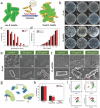Insights into 2D MXenes for Versatile Biomedical Applications: Current Advances and Challenges Ahead
- PMID: 30356929
- PMCID: PMC6193163
- DOI: 10.1002/advs.201800518
Insights into 2D MXenes for Versatile Biomedical Applications: Current Advances and Challenges Ahead
Abstract
Great and interdisciplinary research efforts have been devoted to the biomedical applications of 2D materials because of their unique planar structure and prominent physiochemical properties. Generally, ceramic-based biomaterials, fabricated by high-temperature solid-phase reactions, are preferred as bone scaffolds in hard tissue engineering because of their controllable biocompatibility and satisfactory mechanical property, but their potential biomedical applications in disease theranostics are paid much less attention, mainly due to their lack of related material functionalities for possibly entering and circulating within the vascular system. The emerging 2D MXenes, a family of ultrathin atomic nanosheet materials derived from MAX phase ceramics, are currently booming as novel inorganic nanosystems for biologic and biomedical applications. The metallic conductivity, hydrophilic nature, and other unique physiochemical performances make it possible for the 2D MXenes to meet the strict requirements of biomedicine. This work introduces the very recent progress and novel paradigms of 2D MXenes for state-of-the-art biomedical applications, focusing on the design/synthesis strategies, therapeutic modalities, diagnostic imaging, biosensing, antimicrobial, and biosafety issues. It is highly expected that the elaborately engineered ultrathin MXenes nanosheets will become one of the most attractive biocompatible inorganic nanoplatforms for multiple and extensive biomedical applications to profit the clinical translation of nanomedicine.
Keywords: MXenes; materials science; nanomedicines; surface chemistry; theranostics.
Figures












Similar articles
-
2D MXene Nanomaterials for Versatile Biomedical Applications: Current Trends and Future Prospects.Small. 2021 Nov;17(46):e2100946. doi: 10.1002/smll.202100946. Epub 2021 Jul 29. Small. 2021. PMID: 34323354 Review.
-
MXene in the lens of biomedical engineering: synthesis, applications and future outlook.Biomed Eng Online. 2021 Apr 1;20(1):33. doi: 10.1186/s12938-021-00873-9. Biomed Eng Online. 2021. PMID: 33794899 Free PMC article. Review.
-
Biomedical engineering of two-dimensional MXenes.Adv Drug Deliv Rev. 2022 May;184:114178. doi: 10.1016/j.addr.2022.114178. Epub 2022 Feb 26. Adv Drug Deliv Rev. 2022. PMID: 35231544 Review.
-
Recent development and prospects of surface modification and biomedical applications of MXenes.Nanoscale. 2020 Jan 23;12(3):1325-1338. doi: 10.1039/c9nr07616f. Nanoscale. 2020. PMID: 31872839 Review.
-
Two-dimensional biomaterials: material science, biological effect and biomedical engineering applications.Chem Soc Rev. 2021 Oct 18;50(20):11381-11485. doi: 10.1039/d0cs01138j. Chem Soc Rev. 2021. PMID: 34661206 Review.
Cited by
-
Shedding Light on Miniaturized Dialysis Using MXene 2D Materials: A Computational Chemistry Approach.ACS Omega. 2021 Feb 25;6(9):6312-6325. doi: 10.1021/acsomega.0c06118. eCollection 2021 Mar 9. ACS Omega. 2021. PMID: 33718722 Free PMC article.
-
Roles of Two-Dimensional Materials in Antibiofilm Applications: Recent Developments and Prospects.Pharmaceuticals (Basel). 2024 Jul 16;17(7):950. doi: 10.3390/ph17070950. Pharmaceuticals (Basel). 2024. PMID: 39065800 Free PMC article. Review.
-
Computational Studies of Auto-Active van der Waals Interaction Molecules on Ultra-Thin Black-Phosphorus Film.Molecules. 2023 Jan 9;28(2):681. doi: 10.3390/molecules28020681. Molecules. 2023. PMID: 36677738 Free PMC article.
-
Graphene and other 2D materials: a multidisciplinary analysis to uncover the hidden potential as cancer theranostics.Theranostics. 2020 Apr 7;10(12):5435-5488. doi: 10.7150/thno.40068. eCollection 2020. Theranostics. 2020. PMID: 32373222 Free PMC article. Review.
-
Two-dimensional transition metal carbides and nitrides (MXenes) based biosensing and molecular imaging.Nanophotonics. 2022 Nov 14;11(22):4977-4993. doi: 10.1515/nanoph-2022-0550. eCollection 2022 Dec. Nanophotonics. 2022. PMID: 39634292 Free PMC article. Review.
References
-
- Ashley C. E., Carnes E. C., Phillips G. K., Padilla D., Durfee P. N., Brown P. A., Hanna T. N., Liu J., Phillips B., Carter M. B., Carroll N. J., Jiang X., Dunphy D. R., Willman C. L., Petsev D. N., Evans D. G., Parikh A. N., Chackerian B., Wharton W., Peabody D. S., Brinker C. J., Nat. Mater. 2011, 10, 389. - PMC - PubMed
-
- Mura S., Nicolas J., Couvreur P., Nat. Mater. 2013, 12, 991. - PubMed
Publication types
LinkOut - more resources
Full Text Sources
